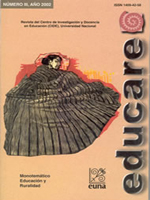La nueva escuela rural unidocente
DOI:
https://doi.org/10.15359/ree.2002-3.6Abstract
This research has been developed in coordination with SIMED, a project for improving the quality of education, and the National Office for the Support of multi-grade classrooms. The main objective was to identify the lever of achievement reached in the development of the thirteen strategies forming part of the model at the leading school in a sample of thirty schools chosen from the eighty-six participating in the project.
The most important conclusions of this study include the educators´ high degree of identification with their work, the interest that they have in further training, and the support ha the project received from both parents and children. With reference to the development of strategies, the most successful are the drafting of annual plans, lesson planning and institutional management. The least developed include the educational project in institutions, flexible evaluation and promotion, and the work carried out with parents.References
Borbón, R.y otros ( 1995). Guía para el desarrollo del currículo de las
escuelas unidocentes. San José, Varitec, Sociedad Anónima.
Ministerio de Educación Pública, (1998). Proyecto de Apoyo al SIMED.
Tercera etapa, San José. Material mimeografiado.
Motta Di Mare C. y otros, (1997). Concepto, fimdamentos y características de la escuela líder. San José. Proyecto de apoyo al SIMED.
Proyecto UNESCO Países Bajos 519/ COS /12 ( 1998). Apoyo al Sistema
Nacional de Mejoramiento de la Calidad de la Educación Costarricense. SIMED. Documento del Proyecto, Fase II. Material poligrafiado.
Downloads
Published
How to Cite
Issue
Section
License
1. In case the submitted paper is accepted for publication, the author(s) FREELY, COSTLESS, EXCLUSIVELY AND FOR AN INDEFINITE TERM transfer copyrights and patrimonial rights to Universidad Nacional (UNA, Costa Rica). For more details check the Originality Statement and Copyright Transfer Agreement
2. REUTILIZATION RIGHTS: UNA authorizes authors to use, for any purpose (among them selfarchiving or autoarchiving) and to publish in the Internet in any electronic site, the paper´'s final version, both approved and published (post print), as long as it is done with a non commercial purpose, does not generate derivates without previous consentment and recognizes both publisher's name and authorship.
3. The submission and possible publication of the paper in the Educare Electronic Journal is ruled by the Journal’s editorial policies, the institutional rules of Universidad Nacional and the laws of the Republic of Costa Rica. Additionally, any possible difference of opinion or future dispute shall be settled in accordance with the mechanisms of Alternative Dispute Resolution and the Costa Rican Jurisdiction.
4. In all cases, it is understood that the opinions issued are those of the authors and do not necessarily reflect the position and opinion of Educare, CIDE or Universidad Nacional, Costa Rica. It is also understood that, in the exercise of academic freedom, the authors have carried out a rogorous scientific-academic process of research, reflection and argumentation thar lays within the thematic scope of interest of the Journal.
5. The papers published by Educare Electronic Journal use a Creative Commons License:














 The articles published by Educare Electronic Journal can be shared with a Creative Commons License:
The articles published by Educare Electronic Journal can be shared with a Creative Commons License: 



